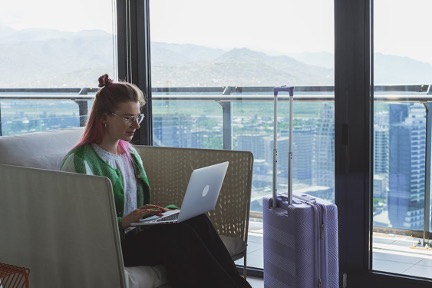Since 2020, more professionals have embraced remote work thanks to digital tools and online platforms. While this has ushered in a lot of benefits, like better work-life balance, some remote workers have reported that they’ve struggled with maintaining their productivity. Studies show that while some office leaders think this dip in productivity is due to a lack of accountability, the real reason is more nuanced. Workers who are finding it challenging to stay productive may be dealing with personal factors that affect their performance.
One of these factors can be the working environment. As we discussed in a previous post about noise levels, where you work influences your productivity. The less comfortable your work setup is, the less likely you are to think clearly and effectively. As it happens, the blue light emitted by the gadgets used by most remote workers can have vast mental and physical impacts that eventually color productivity.
Understanding blue light and its effects
Lately, blue light is a buzzword that people use without really understanding it. For starters, blue light comes from both artificial and natural light sources. In fact, the sun is the largest source of blue light that most people are exposed to on the regular. Apart from monitors and screens, artificial blue light also comes from less obvious technology like fluorescent bulbs and LEDs. Given how many sources of blue light there are, it makes sense that it comprises ⅓ of all visible light.
Second, not all blue light is bad since it does come in a spectrum. In controlled “doses,” blue turquoise light can help regulate critical aspects of well-being like moods, sleep cycle, and cognition. Unfortunately, like all things, excessive amounts can create harmful results. This can cause overexposure to the harmful blue-violet light that causes issues with eye health, like straining, dryness, and blurriness. When the eyes are fatigued or irritated, this can create a domino effect that includes headaches from the muscular tension, poor concentration from the discomfort, and lackluster sleep due to the pain. This ultimately hurts productivity since a tired and sick worker is unable to think clearly or perform efficiently. As it stands, most people are overexposed to blue light with the global average for daily screen use now almost seven hours. Among remote workers, this number can swell to over 13 hours.
How to curb blue light’s impact
Be stricter with your work hours
Since most excess blue light exposure comes from gadgets, cutting down on your screen time is the most natural solution. For remote workers, this may be easier said than done since most of their screen time is tied to work. If you struggle with ending your workday yourself, consider using apps that can send you reminders to take breaks or log off for the night. This way, you’re not tempted to extend your screen time, and you can give your eyes a much-needed rest. Additionally, evidence suggests that workers who work more controlled hours are happier and more engaged, which reflects in productivity, too.
Wear blue light glasses
Since blue light does come from virtually everywhere, it pays to have an extra layer of protection at all times. This is where blue light glasses come in. These glasses are available with or without prescription, but what makes them special is the filter on the lenses. Designed to filter out only harmful blue-violet light, these glasses can reduce any oxidative stress on retinal tissue, which is the foundation for many long-term vision problems. While many people think blue light glasses are only meant for computers, you comfortably wear them anytime and anywhere, no matter if you’re working on your laptop, checking emails on your phone, or even taking a break outside.
Use blue light screen protectors
Finally, if you really want to limit as much blue light as possible, try using blue light filters and settings directly on your gadgets. In tandem with blue light glasses, this will ensure fewer rays reach and enter your eyes. Most devices like Mac or Android have built-in blue light features, which may sometimes be called “eye comfort” settings. By adjusting a screen’s color temperature to a warmer one, these settings allegedly reduce the blue light a device emits. In the event that your gadgets don’t have these or you don’t want to alter the temperature of your screen for work, you can also opt to apply your own separate blue light filter. These come with glass screen protectors and can block up to 60% of harmful blue light.




Comments are closed.